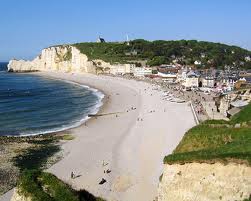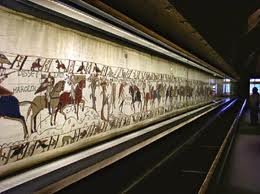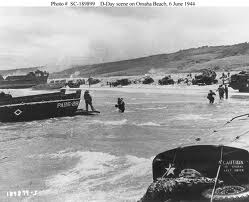
If you’re interested in history then a day trip to the D-Day beaches on the coast of Normandy is sure to interest you.
The tragic and moving story of the landings in June 1944 is documented by the Caen memorial and the Omaha Beach Visitor center. Bayeux is the perfect town to make your base as it is within easy striking distance of both memorials. Adding to its significance, during World War II, Bayeux was the first city in France to be liberated in the Battle of Normandy.
On 14th June 1944 General Charles de Gaulle, the commander of the Free French Forces, first stepped back onto French soil after his exile in London and two days later, on 16th June, he used Bayeux as the location of his first major speech, celebrating the real fighting France and restoring national authority.
Don’t forget to visit Bayeux War Cemetery, which includes the largest British cemetery dating from the Second World War. The soldiers buried here were mostly killed in the game changing invasion of Normandy.
This is, in fact, the spine-tingling cemetery that private Ryan walks through in the opening and closing sequences of Saving Private Ryan.
Wondering why the name Bayeux rings a bell? One word: tapestry. This 70m long piece of embroidered cloth is generally the main incentive for the millions of tourists that flock to Bayeux each year. The Bayeux tapestry, made in commemoration of the events of the Norman Conquest in England in 1066, is the oldest surviving complete tapestry in the world.
If you believe the legends, the Bayeux tapestry was made by Queen Mathilde, wife of William the Conqueror but the most likely theory is that it was commissioned by William's brother Bishop Odo and designed and woven in England.
The tapestry tells the story of the Norman conquest of England with Harold Godwinson's Anglo-Saxon troops fighting against the Normans led by William the Conqueror.

There are certain mysteries surrounding the Bayeux tapestry, mainly to do with two missing panels (6.4m worth) that would detail William's coronation.
There is also a rather racy segment of embroidery depicting a clergyman hitting a woman while two very naked men lurk in the background. Historians believe that the best explanation for this is that there was some kind of well known scandal of the day that needed no explanation.
Originally housed in Bayeux’s gothic cathedral (which is incidentally also worth a visit) the tapestry now has its very own museum which is open to the public every day.
The “Tapisserie de Bayeux” museum has different audio and written guides to give you a hand in deciphering what you're looking at as you walks along the cloth's length.
The Caen Memorial was opened on June 6, 1988 (at the 44th anniversary of D-Day) and is considered by connoisseurs as the best World War II museum in France.

The memorial, which was built on the site of an old bunker, doesn't leave anyone indifferent and invites to meditate about the evils of war with an exhibit that displays not only the rise of Hitler and the Nazis, but also about the consequences of the Cold War and 9-11. In fact the Memorial's musée pour la paix was the first museum outside of the United States to include 9-11 artifacts.
Omaha Beach was one of the five landing beaches during the Allied invasion of German-occupied France on 6th June 1944. That day over 3000 Americans and 1,200 Germans lost their lives on the beach.
On a cliff overlooking Omaha Beach sits the Normandy American Cemetery which is the final resting place of 9,387 American soldiers, most of whom died during the D-Day landings and subsequent operations. The seemingly endless rows of white graves are a somber sight, yet it must never be forgotten.
There is a visitor center explaining in detail the military operations and staff on duty can escort you to a specific grave.
These harrowing memorials are vital in their role of ensuring that we never forget and impressing upon us the importance of learning not to make the same mistakes again, from past failures and successes, but most of all the imperative need to find lasting peace.
Trains from Paris for Bayeux leave from St. Lazare station and the direct train will take around 2 hours. There is also a train which requires a change at Caen which takes 2 and a half hours to reach Bayeux.
The Normandy American Cemetery is open to the public every day, except on Christmas (December 25) and New Year (January 1). The opening hours are 9 a.m. to 6 p.m. from April 15 to September 15, and 9 a.m. to 5 p.m. the rest of the year.